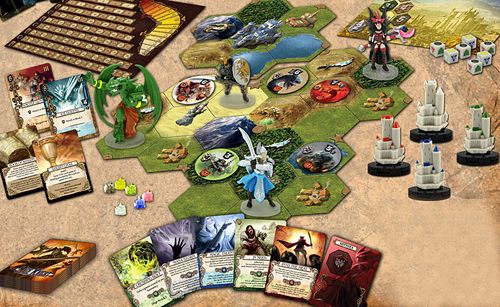
Courtesy Theology of Games
There are only a few board games that one can play entirely on their own. They essentially become very complex puzzles that you setup and solve on the fly, rather than being assembled, disassembled, or arranged correctly. Sometimes this is fine, but for the most part, you’ll want to get other people involved with your games. That means, you have to teach them the rules.
The rules of any given game provide the framework and nature of the challenge that game presents. They’re essential to board games of all shapes and sizes. But teaching said rules does not have to be a dull undertaking that fills up time you could spend playing and having fun with tedious rules explanations that sound just short of obfuscatory legalese. Here are a couple basic tips for making a session of teaching the rules of the game not suck.
Don’t just read from the rulebook.
Direct reading of rules from a rulebook to a potential player is poison to the interest in the game. While some gamers will still be fascinated by how the rules interlace or the ramifications of certain situations, new players in particular (especially if they don’t often play board games) will not want to hear the dry, uncharacterized rules right from the off. That will just play up the stodgy stereotype of board games and the people who play them, and we do not want that.
Instead, give the players an idea of what their options are on their turn. As much as this can lead to players being somewhat isolated in early turns, it puts their focus on what’s in front of them. “So you have these cards, these pieces, and this objective in mind. What do you want to do next?” When they decide what they want to do, be it for the objective or just for fun, encourage them and show them how its done while explaining any rules involved. It gets you playing faster, it gives context to the rules, and it pulls new players in quickly.
Introduce components before rules.
The other problem with rules explanations is that it requires new players to focus entirely on what you’re saying, and it needs to make sense. Dry readings from the rulebook can be very difficult to make interesting or even sensical, as some rulebooks are more reference sources than coherent reading experiences (looking at you, Fantasy Flight Games). But your board game has more than just the board and the rulebook – you have components, cards, dice, miniatures, and all sorts of things that can help your players pay attention.
I can’t take credit for this one. Quinns from Shut Up & Sit Down pointed out that people are actually more attentive if they have something in their hands. If they’re just sitting there listening to a tutorial, they are unlikely to retain everything they hear. Give them a component, a hand of cards, or some currency or tokens, and suddenly they’re paying more attention. This also ties into the previous point of giving them options for their first turn. Tying your explanation into what they’re holding and what their choices might be engages them in the proceedings right from the off.
If you’re going to teach it, know it.
This might seem like a no-brainer. And it doesn’t apply to all situations. If you’re unboxing a game for the very first time in front of new players, it’s impossible for you to know the game front to back the way you really should in order to teach it. But this is likely to be a rare occurrence. Most of the time, you’ll have the game before the time comes to play it. In that case, you should know it before you teach it.
This will help you in not reading dry rules from the rulebook, getting new players involved, and focusing more on their opening moves than on what the rules say.
Provide personal examples.
Most people like to hear stories. Many also like to tell them. There are some humorless folks out there who don’t want some silly story about emotions and morals and personal interest to interfere in their action, but that’s usually more applicable in terms of first-person shooters than board games. When you’re teaching a new game to people, it can be helpful to tell them some of your own experiences with it, especially if you tell them how you’ve lost.
Not only does this help new players figure out what to avoid, it demonstrates that while you know the game, you are not infallible. This will increase their confidence and get them more eager to play the game you’ve taught them. And when the game is over, they’ll have experiences of their own to relate to others!
Don’t take my word for it.
I mentioned Quinns and his site, and he has more tips on rules explanations right here. There are also lots of folks in the comments section to provide guidance. Be sure to check it out here!
Board gaming is a great hobby, and it’s even better when you get more people around the table. The more the merrier may be a somewhat cliched phrase, but it’s true. Even two players tends to be better than one when it comes to board gaming, and some games really come into their own when you get a great number of people playing at the same time. As much as they all need to know the rules, there’s no need for learning said rules to be boring. Make it interesting. Bring them in. And before they know it, they’ll know the rules of the game well enough to teach others. The cycle will continue, the hobby will grow, and more and more games will come out of the basement and into the light.


